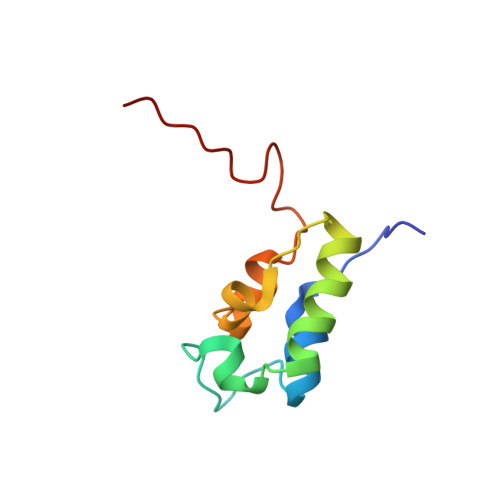A Mammalian type I Fatty Acid synthase acyl carrier protein domain does not sequester acyl chains.
Ploskon, E., Arthur, C.J., Evans, S.E., Williams, C., Crosby, J., Simpson, T.J., Crump, M.P.(2008) J Biol Chem 283: 518-528
- PubMed: 17971456
- DOI: https://doi.org/10.1074/jbc.M703454200
- Primary Citation of Related Structures:
2PNG - PubMed Abstract:
The synthases that produce fatty acids in mammals (FASs) are arranged as large multidomain polypeptides. The growing fatty acid chain is bound covalently during chain elongation and reduction to the acyl carrier protein (ACP) domain that is then able to access each catalytic site. In this work we report the high-resolution nuclear magnetic resonance (NMR) solution structure of the isolated rat fatty acid synthase apoACP domain. The final ensemble of NMR structures and backbone (15)N relaxation studies show that apoACP adopts a single, well defined fold. On conversion to the holo form, several small chemical shift changes are observed on the ACP for residues surrounding the phosphopantetheine attachment site (as monitored by backbone (1)H-(15)N correlation experiments). However, there are negligible chemical shift changes when the holo form is modified to either the hexanoyl or palmitoyl forms. For further NMR analysis, a (13)C,(15)N-labeled hexanoyl-ACP sample was prepared and full chemical shift assignments completed. Analysis of two-dimensional F(2)-filtered and three-dimensional (13)C-edited nuclear Overhauser effect spectroscopy experiments revealed no detectable NOEs to the acyl chain. These experiments demonstrate that unlike other FAS ACPs studied, this Type I ACP does not sequester a covalently linked acyl moiety, although transient interactions cannot be ruled out. This is an important mechanistic difference between the ACPs from Type I and Type II FASs and may be significant for the modulation and regulation of these important mega-synthases.
Organizational Affiliation:
School of Chemistry, University of Bristol, Bristol BS8 1TS, United Kingdom.














